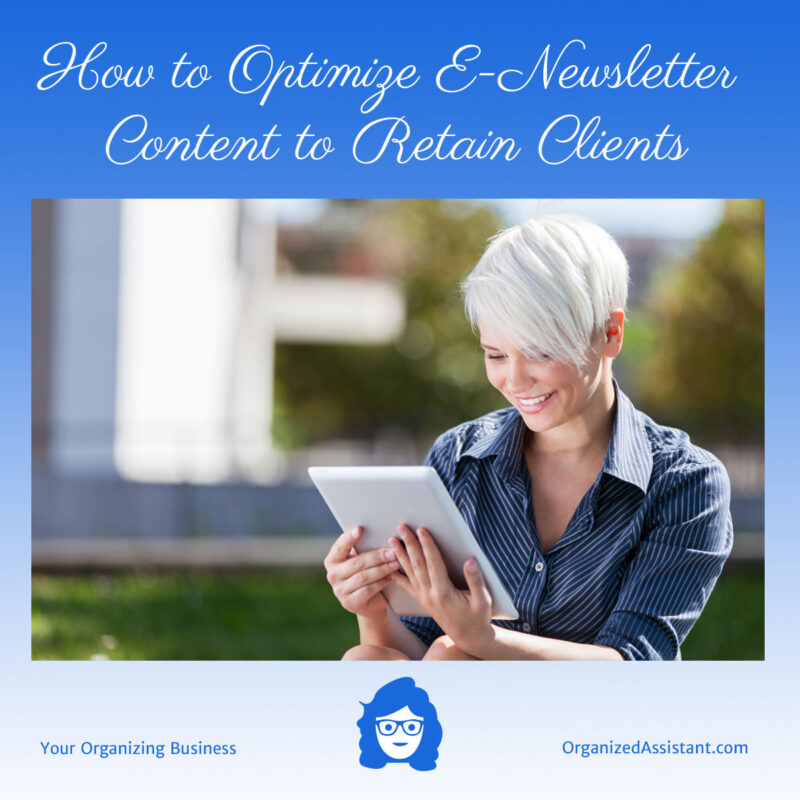How to Optimize E-Newsletter Content to Retain Clients
This page may contain links to Amazon.com or other sites from which I may receive commission on purchases you make after clicking on such links. Read my full Disclosure Policy

One of my most popular guest bloggers last year was productivity blogger Kayla Matthews, so I’m happy to welcome her back today with some great tips to help you optimize your newsletter content and get the most out of your email marketing.

You’ve probably read about how to make your e-newsletter catch people’s attention initially, but what about actively working to achieve client retention with the emailed content? The suggestions below will help you do that.
1. Highlight the Newsletter’s Timely Material
Does your newsletter give the crucial details about newsworthy happenings, provide links to relevant press releases minutes after publication, or feature calendars filled with conferences, lectures and other events that may interest your clients? If so, be sure to draw attention to the fact that your newsletter is a resource for up-to-date content.
You could create a landing page with a bulleted list of typical newsletter content — and focus on the ultra-current nature of what you offer. Otherwise, consider creating a banner ad with a snappy tagline such as, “[Name of newsletter]: The most efficient way to stay abreast of the topics that matter.”
After all, your clients are trying to stay as productive and organized as possible. They won’t want to continue subscribing to a newsletter filled with content so outdated it’s no longer useful. That’s why you need to answer the “What’s in it for me?” question they inevitably have. You might also emphasize that because you strive to find the most updated material available, clients can save time by not having to seek out the information independently.
2. Pay Attention to the Newsletter’s Structure
In the same way a newspaper usually has several sections, your e-newsletter should, too. You can use headers to separate the content.
Don’t be afraid to begin with something personal. Did you get a new dog or recently go on a fun vacation? Bring those things up in the opening section. Sharing details about your life makes you more relatable to clients.
After that, put your most important, useful information first. If you maintain a blog, your newsletter is a great place to link to the most recent posts. When you conclude the newsletter, set expectations and let people know when they’ll hear from you again.
Adhering to a structure gives readers a sense of familiarity each time they click on the subject line of your newsletter. Also, a lack of structure appears chaotic on the screen and can confuse readers, making them more likely to unsubscribe.
3. Send the E-Newsletter Regularly
When determining how often to send your e-newsletter, getting into a routine is crucial. If you sometimes distribute it every week but also occasionally wait over a month before sending it, that amount of fluctuation will frustrate clients and make them think you’re unreliable. It may even cause them to assume you’re too disorganized to distribute the e-newsletter on a regular basis.
Besides sending the newsletter on a predictable timeframe, what should you keep in mind about frequency? Statistics collected in 2015 by the Direct Marketing Association indicate 54% of marketers send from one to three emails per month. However, that data was for all kinds of emails, not just newsletters.
Monitor subscriber behaviors and direct feedback, and use it as guidance to help choose a frequency. If 30% of your readers unsubscribed within a week of when you began sending weekly emails, that’s not a good sign, but it’s not necessarily the frequency that caused them to take that action. Try to gain an all-encompassing picture of how subscribers feel.
Also, they may reach out to you and give their opinions. Keep those insights in mind while picking an email distribution schedule as well.
4. Make the Design Mobile-Friendly
According to data collected by Return Path, an email solutions provider, most people open emails on their smartphone. The associated study examined the specifics of over 27 billion opened emails people received between May 2016 and April 2017. The results revealed 55% of those emails were viewed on mobile devices.
With that in mind, make sure your e-newsletter loads correctly on smartphones and tablets, and don’t overload it with gigantic images that eat up data and take several seconds to show up. Select a font that’s easy to read on smaller screens, and ensure the color scheme doesn’t cause eyestrain.
Factors like pleasing colors, loading times and readable fonts are important to be aware of for people who access the e-newsletter on computers, too. However, if clients solely or even mostly read your e-newsletter on mobile devices and find the content’s not suitable, it’ll be difficult to convince them subscribing is worth the hassle.
This list of tips should get you off to a strong start as you edit your existing newsletter to boost subscriber retention. They’re also valuable if you’re creating an email newsletter from scratch and want to avoid common mistakes that could lead to less reader engagement and fewer long-term subscribers. A smart, well-done newsletter will show clients you are worthy of their investment on the job, too, and help you retain clients.




A group I am a part of was just discussing the rise in people reading their newsletters on a mobile device. It is pretty interesting how comfortable we have become reading our content on small screens and while we are out and about. I like your tip about opening your newsletter with something personal. Makes sense to me… feels like it is coming from a person instead of just another piece of marketing.
I wonder if the ability to read newsletters on our phones means that more people will read them, because they can do it while waiting in line, etc., whereas when they’re at their desk they may be more focused on specific tasks…
Thank you! excellent email newsletter suggestions. I send out a quarterly newsletter to our Customer Service Database, but see only 10% of our members opening the newsletter..I was needing some fresh thought on this.
I also create a weekly newsletter for my personal business im getting about 40 opens…I send to about 200 contacts.
These tips you sent will help me with both newsletters.
Thank you
Lisa Gessert
It’s hard to know the actual open rate. For example, if someone has their email show up in a preview window and reads your newsletter there, it usually won’t get tracked as an open. But of course it’s always good to shoot for better results!
Thanks Janet and Kayla!
Good information. I’d never thought about different fonts working better on mobile screens. I have a bit of research to do, I see.
I haven’t named my newsletter either. That would be fun to do and, it seems, it would add to your branding.
It’s not high on my priority list as most of my subscribers read on their computers, but it’s definitely something to think about for the future.
These newsletter suggestions are very helpful to engage the readers. I found for my viewers, they prefer receiving a newsletter once a month. However, over the holidays, I do send out an email more frequently. Thanks for sharing your knowledge.
I think a monthly schedule is good too. More often is not only asking a lot of your subscribers to keep reading, but it’s a lot more work to produce!
These are great suggestions for making the newsletter of more value for our readers. I send out a monthly e-newsletter which automatically formats the most recent blog posts into a newsletter format. It isn’t currently mobile friendly, so that’s something I’d like to work on. Believe it or not, I also still produce a limited quantity “snail mail” newsletter that goes out quarterly. This is an excellent way to stay in touch with clients, especially ones that aren’t tech savvy. The topics are more in line with what you’ve suggested…latest happenings, something personal, organizing tips and resources.
I love that you send out a snail mail newsletter. We get so little in the mail anymore that I bet most people are thrilled to receive it.
They see that purple paper and know that I’m thinking of them. It definitely stands out in a way that the e-newsletter doesn’t. Even if it’s a quick glance and toss, it’s a good touch point.
I like that landing page idea for the newsletter! I may have to work to implement that this year. Thanks for the great tips. Reading this article, I was able to tick off many of the items, so I guess I’m not doing too bad! #feelingvalidated
I love that idea too. So many of us don’t explain what readers can expect to receive if they subscribe – some don’t even say how often it comes out. How can they know if they want it or need it if they don’t know what it is?